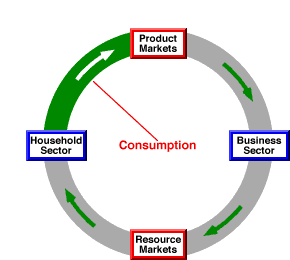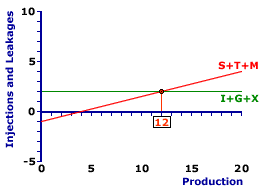
|
|
LONG RUN, MICROECONOMICS: In terms of the microeconomic analysis of production and supply, a period of time in which all inputs in the production process are variable. The long run is primarily used to analyze production decisions for a firm and is also referred to as the planning horizon. The long run is a period of time in which a business can change the quantities of ALL resource inputs--labor, capital, land, and entrepreneurship. Nothing is fixed. If your factory is to small, well then, build a bigger one. The long-run analysis of production is used to better understand economies of scale, diseconomies of scale, and long-run market supply.
Visit the GLOSS*arama
|
|


|

|
                           INJECTIONS-LEAKAGES MODEL: A macroeconomic model that balances non-consumption expenditures on production (injections) and non-consumption uses of income (leakages) that is used to identify the equilibrium level of, and analyze disruptions to, aggregate production and income. The injections-leakages model is based on the principles of Keynesian economics and provides an alternative to the standard aggregate expenditures (Keynesian cross) analysis. The three injections included in the model are investment expenditures, government purchases, and exports. The three leakages included in the model are saving, taxes, and imports. Three variations are the two-sector injections-leakages model (or saving-investment model), three-sector injections-leakages model, and four-sector injections-leakages model. The injections-leakages model provides an alternative to the more common Keynesian cross, aggregate expenditures-aggregate production model of the macroeconomy. Both models provide essentially the same analysis and are essentially "two sides of the same coin." The key difference between the two models is that consumption is explicitly eliminated from the injections-leakages variation. Whereas the Keynesian cross builds on the consumption function, the injections-leakages model builds on the saving function',500,400)">saving function.A Keynesian OverviewKeynesian economics is a theory of macroeconomics developed by John Maynard Keynes based on the proposition that aggregate demand is the primary source of business-cycle instability and the most important cause of recessions. Keynesian economics points to discretionary government policies, especially fiscal policy, as the primary means of stabilizing business cycles and tends to be favored by those on the liberal end of the political spectrum.The basic principles of Keynesian economics were developed by Keynes in his book, The General Theory of Employment, Interest and Money, published in 1936. This work launched the modern study of macroeconomics and served as a guide for both macroeconomic theory and macroeconomic policies for four decades. Injections and LeakagesOne half of the injections-leakages model is injections, which are non-consumption expenditures on aggregate production. The three injections are investment expenditures, government purchases, and exports. These are termed injections because they are "injected" into the core circular flow of consumption, production, and income. The other half of the injections-leakages model is leakages, which are non-consumption uses of the income generated from production. The three leakages are saving, taxes, and imports. These are termed leakages because they are "leaked" out of the core circular flow of consumption, production, and income. Equilibrium in the injections-leakages model relies on a balance between the injections into the core circular flow and leakages out of the flow. If leakages match injections, then the volume of the core circular flow does not change. This is the same as achieving a balance between the water flowing form a faucet into a sink and that flowing out through the drain. When these two flows are equal, then the total amount of water IN the sink does not change. Equilibrium! The Circular Flow| The Circular Flow |  |
Injections and leakages can be best illustrated using the standard circular flow model of the macroeconomy, such as that presented in the exhibit to the right. The circular flow is a handy model of macroeconomic activity that highlights the interaction between households and businesses through the product and resource markets.The business sector is at the right and the household sector is at the left. The product markets are at the top and the resource markets are at the bottom. The household sector buys production from the business sector through the product markets. Expenditures by the household sector are consumption expenditures. Revenue going to the business sector is gross domestic product. The business sector hires factor services from the household sector through the resource markets. Payments made by the business sector are factor payments. Income going to the household sector is national income. These four parts -- consumption expenditures, gross domestic product, factor payments, and national income -- are the core of the circular flow. They are the "engine" that drives the macroeconomy. Let's now consider how injections and leakages relate to this core circular flow. - Injections: The three injections -- investment, government purchases, and exports -- can be displayed by clicking the [Injections] button. These injection expenditures, like consumption, are used to purchase aggregate production through the product markets. Most importantly, injections add to the total volume of the basic circular flow. That is, they "inject" revenue into the product markets that is used for factor payments and becomes household income.
- Leakages: The three leakages -- saving, taxes, and imports -- can be displayed by clicking the [Leakages"] button. These leakages, like consumption, are how the household sector divides up or uses its income. Most importantly, leakages subtract from the total volume of the basic circular flow. That is, they "leak" income away from the product markets, making less available for factor payments and household income.
The critical implication from the circular flow is that a balance between injections and leakages maintains a constant flow of income, consumption, production, and factor payments moving between the household and business sectors. This is the essence of macroeconomic equilibrium -- the level of aggregate production remains unchanged.However, if injections exceed leakages, then the volume of the basic flow expands and aggregate production increases. Alternatively, if leakages exceed injections, then the volume of the basic flow contracts and aggregate production decreases. As we shall see, this change in production is what moves the economy to an equilibrium balance. The Injections-Leakages BalanceA balance between injections and leakages generates the same equilibrium as a balance between aggregate expenditures and aggregate production. A little manipulation of the Y = AE equilibrium condition illustrates why.This last equation indicates that equilibrium can be achieved by equating injections I + G + X with leakages S + T + M. Most importantly, when aggregate expenditures equal aggregate production (Y = AE), then injections are necessarily equal to leakages S + T + M = I + G + X. The Graphical Model| The Injections-Leakages Model |  |
The exhibit to the right presents the injections-leakages model. The horizontal green line, labeled I + G + X, is the injections line and includes investment expenditures (I), government purchases (G), and exports (X). The positively-sloped red line, labeled S + T + M, is the leakages line and includes saving (S), taxes (T), and imports (M). The intersection of the two lines is the equilibrium level of aggregate production, which matches the equilibrium level of aggregate production generated by the Keynesian cross version of the Keynesian model.Three VariationsThe injections-leakages model comes in three common variations, each based on a different combination of the four macroeconomic sectors, and thus a different number of injections and leakages.- Two-Sector Model: The simplest injections-leakages model includes the household and business sectors. Also termed the saving-investment model, this variation is often used to illustrate the basic operation of the model, including adjustment to equilibrium and the multiplier process. The two-sector model captures the role of induced activity through household saving and the role of autonomous expenditures through business investment. Saving is the only leakage and investment is the only injection.
- Three-Sector Model: The second variation of the injections-leakages model adds the government (or public) sector to the household and business sectors contained in the two-sector model. This variation is used to analyze government stabilization policies, especially how fiscal policy changes in government purchases and taxes can be used to close recessionary gaps and inflationary gaps. Saving and taxes are the two leakages. Investment and government purchases are the two injections.
- Four-Sector Model: As the name suggests, all four macroeconomic sectors--household, business, government, and foreign--are included in the four-sector Keynesian model. This model is not only used to capture the interaction between the domestic economic and the foreign sector, but also provides the foundation for detailed, empirically estimated models of the macroeconomy. Saving, taxes, and imports are the three leakages. Investment, government purchases, and exports are the three injections.

Recommended Citation:INJECTIONS-LEAKAGES MODEL, AmosWEB Encyclonomic WEB*pedia, http://www.AmosWEB.com, AmosWEB LLC, 2000-2025. [Accessed: July 18, 2025].
Check Out These Related Terms... | | | | | | | | | |
Or For A Little Background... | | | | | | | | | | | | | | | | |
And For Further Study... | | | | | | | | | |
Related Websites (Will Open in New Window)... | |
Search Again?
Back to the WEB*pedia
|



|

|
BROWN PRAGMATOX
[What's This?]
Today, you are likely to spend a great deal of time browsing through a long list of dot com websites seeking to buy either a case of blank recordable DVDs or a pair of red goulashes with shiny buckles. Be on the lookout for mail order catalogs with hidden messages.
Your Complete Scope
This isn't me! What am I?
|

|
|
Natural gas has no odor. The smell is added artificially so that leaks can be detected.
|

|
|
"A winner is someone who recognizes his God-given talents, works his tail off to develop them into skills, and uses those skills to accomplish his goals. " -- Larry Bird, basketball player
|

|
AASB
American Assocation of Small Business
|

|
|
Tell us what you think about AmosWEB. Like what you see? Have suggestions for improvements? Let us know. Click the User Feedback link.
User Feedback
|


|


